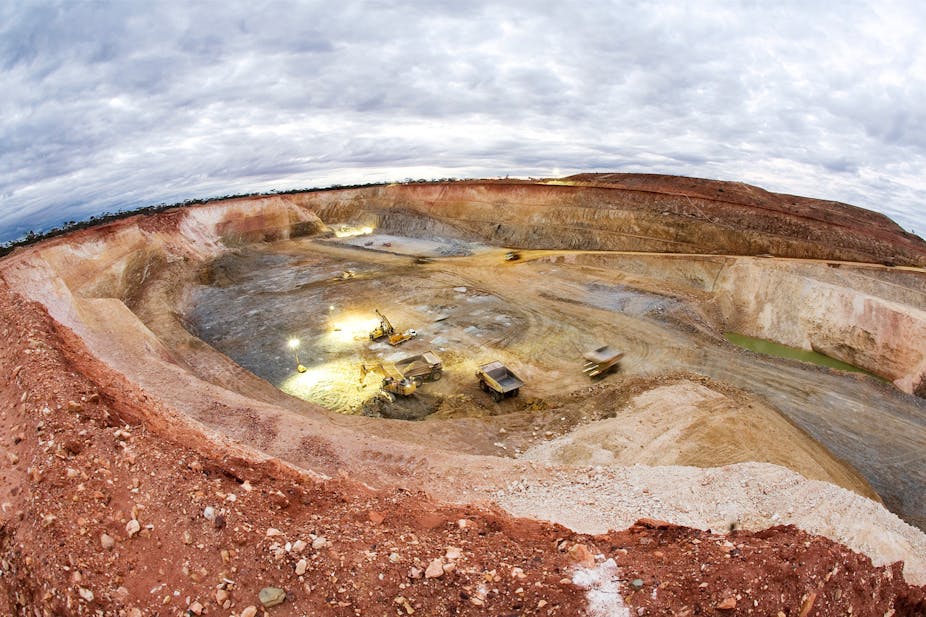Australia’s stark comparative advantage in mining is both a boon and a bane to our economic development. Investment in the mining industry as a share of Australia’s GDP has already reached unprecedented levels and looks set to double in coming years.
The mining industry is almost single-handedly responsible for Australia experiencing close to trend annual growth while the rest of the developed world languishes.
Yet the mining boom unleashes mighty structural forces that bear down on the Australian economy. A strongly appreciating Australian dollar - driven by high commodities prices and strong demand for Australian mineral exports - undermines the competitiveness of non-mining export activities, including manufacturing and services exports, and encourages local consumers to prefer imports over locally-sourced goods and services.
Shortages of skilled labour – in fact, any labour at all – in mining regions drives wages and salaries to stratospheric levels, in turn bidding up prices for accommodation, food and local services. This makes life very difficult for individuals and families who do not benefit directly from inflated incomes and yet also face inflated prices for basic goods and services in regions affected by the mining boom.
Broadly speaking, investment has moved from the south and east of Australia, where most people live and work, to the north and west of the continent, where most of the mineral wealth lies. There is a parallel movement of capital away from low-productivity sectors like manufacturing and retail trade towards high-productivity mining and related services. This is not only to be expected but also welcomed, as Australia struggles with declining average productivity levels.
How we cope with the changing pattern of demand for labour, especially skilled labour, will determine how well we manage the mining boom. Ways must be found simultaneously to meet the needs of the mining sector and to ensure that the non-mining sector realises improvements in efficiency and productivity sufficient to allow it to survive the boom.
Indeed, this is the non-mining sector’s best hope: that productivity levels can be raised so that labour is released to serve the mining industry without harming output levels in the rest of the economy.
It’s not only the economic fabric that is stressed and strained by the booming sector “problem”. Social challenges also arise when investment and jobs move away from where people live and community life is established. One trend is the rapid take-up of “fly in/fly out” (FIFO) employment patterns.
One respondent to a recent Senate inquiry expects FIFO employment to increase six-fold over the next 20 years, while relocation and local recruitment will barely double. FIFO might represent a handy way to avert the cost of relocating workers and their families to remote regions, but it comes at a cost to family relationships and community life more broadly.
It also stymies the broader economic development of the regions blessed - or cursed - with mineral wealth. It is the equivalent at a local level of wholly imported capital and labour working the mines in Africa, leaving local residents with little if anything to show for their “development” apart from higher food prices.
There are numerous alternatives to FIFO as a means of closing the geographic and skills gaps opened up by the mining boom. In a recent report entitled Where’s your next worker?, Deloitte explored twelve alternative strategies for bringing workers to jobs and jobs to workers.
Promoting the use of shared services is clearly one of them. This includes but is not limited to offshoring. “Near-shoring” - that is, accessing shared services providers located interstate within Australia rather than overseas - can often be a more competitive alternative when full account is taken of management costs and cultural differences. Either way, there is a pressing need for productivity improvements in the non-mining sector as there is for services to be supplied to the booming mining sector, and shared services models help to satisfy both needs.
Beyond shared services, there are other ways to augment the supply of skills without moving local workers around so much. Boosting skilled migration must continue as a priority and, in this vein, the government’s recently announced US–Australia Bilateral Employment Initiative is to be welcomed. Here is a way of tapping unemployed or underemployed tradespeople in the United States for short-term employment in Australia, where demand outstrips supply.
“Crowd-sourcing” skills is yet another and more innovative solution. Digital communications and social media are in their infancy, yet the potential for tapping expertise over the internet is huge. Australian internet start-up, Kaggle, is just one example of what is possible, where technical problems are thrown to the crowd with little more than the thrill of the challenge offered by way of motivation.
Other solutions include enhancing opportunities for retirees, home-based carers, people with disabilities and indigenous Australians to participate more actively in the paid workforce. In the case of indigenous Australians, at least one of the gaps – the geographic gap – is generally already closed. But others, including skills and disadvantage, still loom large.
More can be done to improve employee engagement as well as re-engineering jobs so that workers are more effective in what they do.
Delivering more and better skilled labour is not just about moving workers around, although this will be part of any solution.
Importantly, measures which improve the productivity of the existing workforce, including at a distance from the workplace, will help resolve the tensions born of our prodigious mineral endowment.
The measure of how successfully we manage the mining boom is how well we respond to the resulting structural pressures placed on labour markets.
Ian Harper is a Partner at Deloitte and a director of Deloitte Access Economics Pty Ltd. This formed part of an address Ian gave at the Shared Services & Outsourcing Convention in Melbourne.

